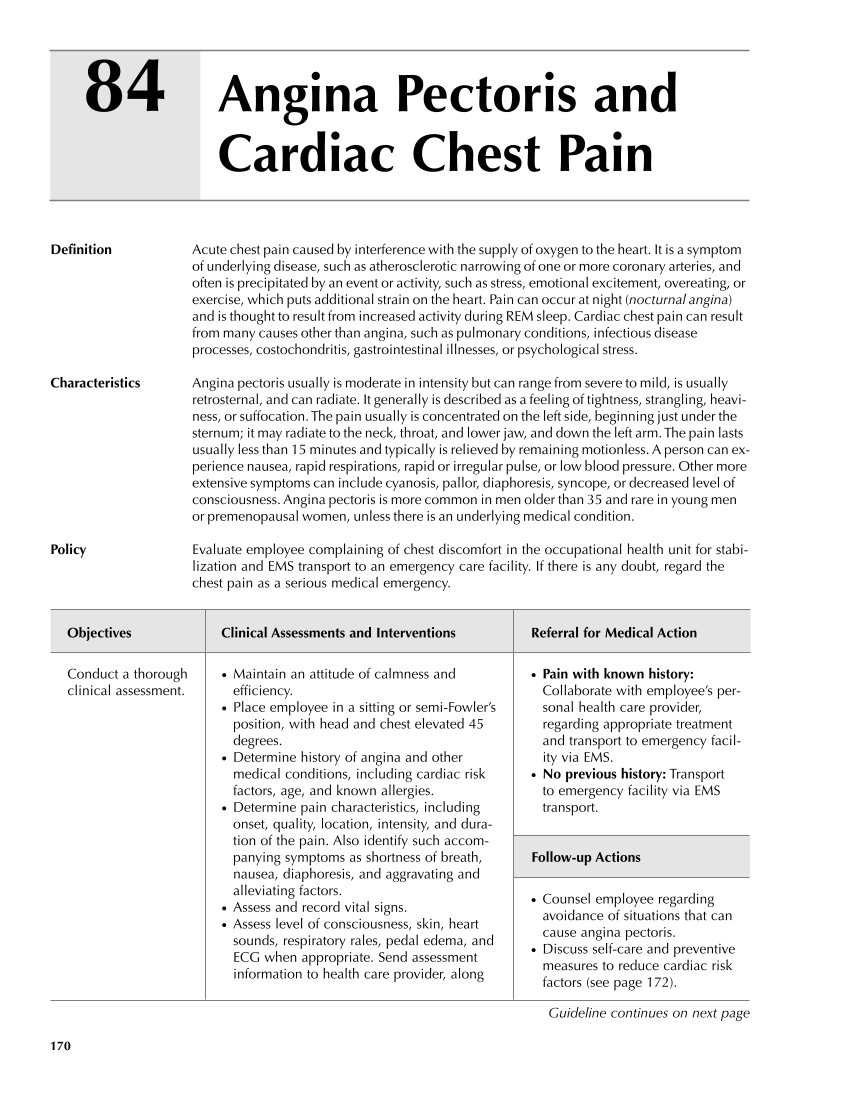84 170 Definition Acute chest pain caused by interference with the supply of oxygen to the heart. It is a symptom of underlying disease, such as atherosclerotic narrowing of one or more coronary arteries, and often is precipitated by an event or activity, such as stress, emotional excitement, overeating, or exercise, which puts additional strain on the heart. Pain can occur at night (nocturnal angina) and is thought to result from increased activity during REM sleep. Cardiac chest pain can result from many causes other than angina, such as pulmonary conditions, infectious disease processes, costochondritis, gastrointestinal illnesses, or psychological stress. Characteristics Angina pectoris usually is moderate in intensity but can range from severe to mild, is usually retrosternal, and can radiate. It generally is described as a feeling of tightness, strangling, heavi- ness, or suffocation. The pain usually is concentrated on the left side, beginning just under the sternum it may radiate to the neck, throat, and lower jaw, and down the left arm. The pain lasts usually less than 15 minutes and typically is relieved by remaining motionless. A person can ex- perience nausea, rapid respirations, rapid or irregular pulse, or low blood pressure. Other more extensive symptoms can include cyanosis, pallor, diaphoresis, syncope, or decreased level of consciousness. Angina pectoris is more common in men older than 35 and rare in young men or premenopausal women, unless there is an underlying medical condition. Policy Evaluate employee complaining of chest discomfort in the occupational health unit for stabi- lization and EMS transport to an emergency care facility. If there is any doubt, regard the chest pain as a serious medical emergency. Objectives Clinical Assessments and Interventions Referral for Medical Action Angina Pectoris and Cardiac Chest Pain ● Pain with known history: Collaborate with employee’s per- sonal health care provider, regarding appropriate treatment and transport to emergency facil- ity via EMS. ● No previous history: Transport to emergency facility via EMS transport. Follow-up Actions ● Counsel employee regarding avoidance of situations that can cause angina pectoris. ● Discuss self-care and preventive measures to reduce cardiac risk factors (see page 172). Conduct a thorough clinical assessment. ● Maintain an attitude of calmness and efficiency. ● Place employee in a sitting or semi-Fowler’s position, with head and chest elevated 45 degrees. ● Determine history of angina and other medical conditions, including cardiac risk factors, age, and known allergies. ● Determine pain characteristics, including onset, quality, location, intensity, and dura- tion of the pain. Also identify such accom- panying symptoms as shortness of breath, nausea, diaphoresis, and aggravating and alleviating factors. ● Assess and record vital signs. ● Assess level of consciousness, skin, heart sounds, respiratory rales, pedal edema, and ECG when appropriate. Send assessment information to health care provider, along Guideline continues on next page
Purchased from OEM Press by (ge corporate access). (C) 2013 OEM Health Information, Inc. All rights reserved.












































































































































































































































































































































































































































